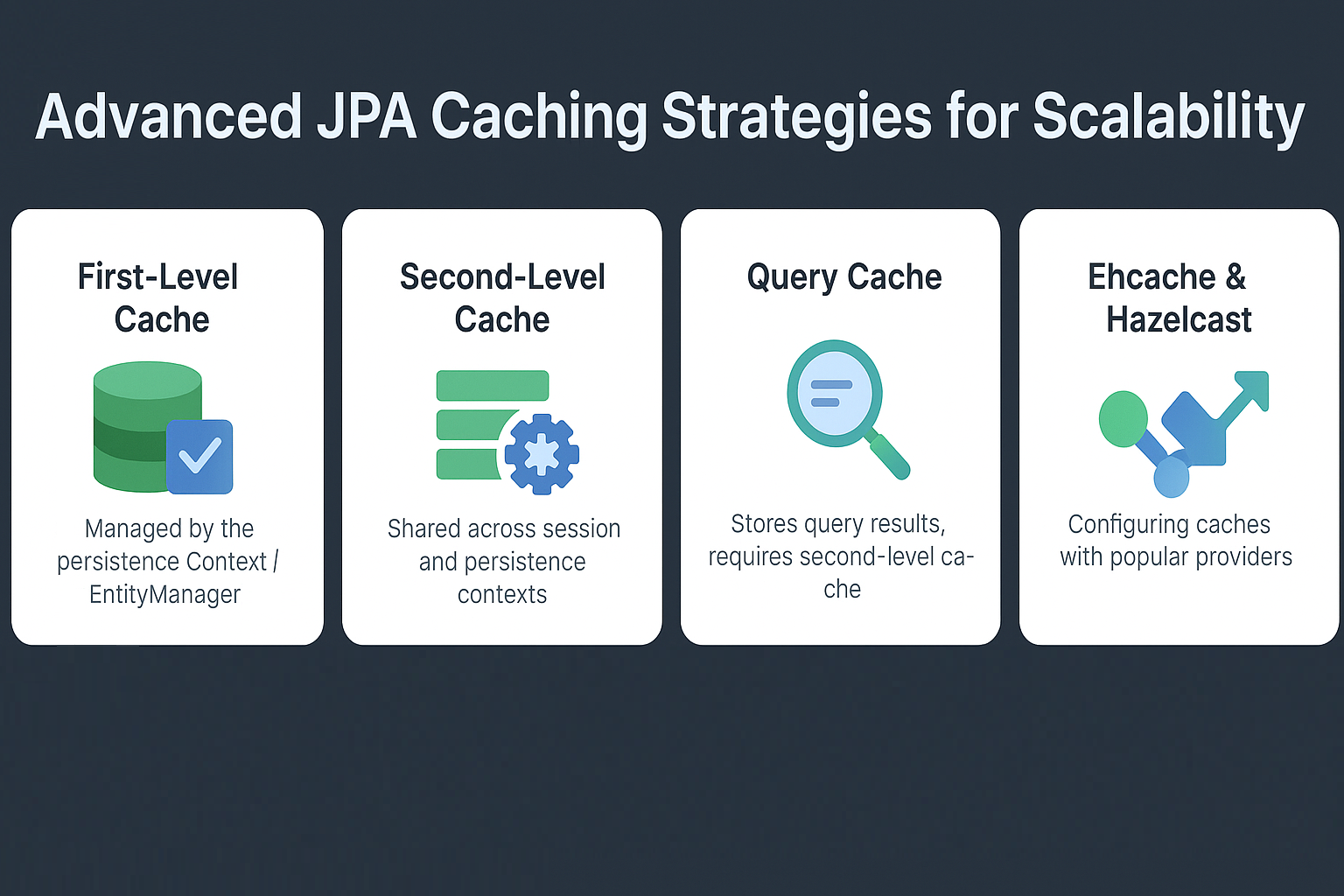As enterprise applications scale, database access often becomes a bottleneck. Every database round trip costs network time, resources, and processing power. Caching in JPA (Jakarta Persistence API) provides a solution by reducing redundant database queries and improving application responsiveness.
Caching works like a library’s lending desk—instead of fetching the same book from the storage room each time, frequently accessed books are kept at the desk for faster access.
This tutorial explores advanced caching strategies in JPA, from first-level caching to distributed second-level caching for scalable, high-performance applications.
Types of Caching in JPA
1. First-Level Cache (Mandatory)
- Managed by the Persistence Context (per
EntityManager). - Caches entities within a transaction.
- Example: When you call
em.find()twice for the same entity ID, the second call fetches from cache, not the database.
EntityManager em = emf.createEntityManager();
em.getTransaction().begin();
Customer c1 = em.find(Customer.class, 1L); // DB call
Customer c2 = em.find(Customer.class, 1L); // Cached
em.getTransaction().commit();
em.close();
2. Second-Level Cache (Optional)
- Shared across sessions and persistence contexts.
- Requires explicit configuration with providers like Ehcache, Hazelcast, Infinispan.
- Great for read-heavy applications.
3. Query Cache
- Stores query results, not entities.
- Requires second-level cache + explicit enabling.
- Useful for repeated JPQL queries with the same parameters.
Enabling Second-Level Cache
Hibernate + Ehcache Example
persistence.xml
<persistence xmlns="https://jakarta.ee/xml/ns/persistence" version="3.0">
<persistence-unit name="cachePU">
<provider>org.hibernate.jpa.HibernatePersistenceProvider</provider>
<properties>
<property name="hibernate.cache.use_second_level_cache" value="true"/>
<property name="hibernate.cache.use_query_cache" value="true"/>
<property name="hibernate.cache.region.factory_class" value="org.hibernate.cache.jcache.JCacheRegionFactory"/>
<property name="hibernate.javax.cache.provider" value="org.ehcache.jsr107.EhcacheCachingProvider"/>
</properties>
</persistence-unit>
</persistence>
Entity Configuration
@Entity
@Cacheable
@org.hibernate.annotations.Cache(usage = CacheConcurrencyStrategy.READ_WRITE)
public class Product {
@Id
@GeneratedValue(strategy = GenerationType.IDENTITY)
private Long id;
private String name;
private double price;
}
Distributed Caching with Hazelcast
For scalable cloud-native applications, use distributed caching.
Example
<property name="hibernate.cache.region.factory_class" value="com.hazelcast.hibernate.HazelcastCacheRegionFactory"/>
<property name="hibernate.cache.use_second_level_cache" value="true"/>
<property name="hibernate.cache.use_query_cache" value="true"/>
Hazelcast ensures cache synchronization across multiple application nodes.
Query Caching Example
List<Product> products = em.createQuery("SELECT p FROM Product p WHERE p.price > :min", Product.class)
.setParameter("min", 100)
.setHint("org.hibernate.cacheable", true)
.getResultList();
CRUD with Cache Interaction
@Stateless
public class ProductService {
@PersistenceContext
private EntityManager em;
public void createProduct(Product p) {
em.persist(p);
}
public Product getProduct(Long id) {
return em.find(Product.class, id); // First-level, then second-level cache
}
public Product updateProduct(Product p) {
return em.merge(p); // Updates cache + DB
}
public void deleteProduct(Long id) {
Product p = em.find(Product.class, id);
if (p != null) em.remove(p); // Evicts from cache
}
}
Performance Considerations
- Lazy vs Eager Loading: Use lazy loading with cache to avoid bloating memory.
- Invalidation Strategy: Ensure cache eviction on updates to avoid stale data.
- Batch Fetching: Reduce DB round trips before caching.
- Monitoring: Use metrics from Ehcache, Hazelcast, or Infinispan.
Real-World Use Cases
- E-Commerce Catalogs: Cache product details for faster lookups.
- Banking Systems: Cache customer profiles for quick verification.
- SaaS Platforms: Use distributed caches for global deployments.
Common Pitfalls
- Overusing Query Cache: Can lead to stale results if not invalidated.
- Caching Write-Heavy Entities: Adds overhead without benefits.
- Ignoring Eviction Policies: Risk of memory leaks.
- Assuming Cache = Performance: Cache misuse can hurt scalability.
Best Practices
- Cache read-mostly entities (products, catalogs, reference data).
- Always configure TTL (time-to-live) or eviction policies.
- Use distributed caching in microservices or cloud setups.
- Combine caching with DTO projections for high throughput.
- Monitor hit/miss ratios continuously.
📌 JPA Version Notes
- JPA 2.0: Standardized
@Cacheableannotation. - JPA 2.1: Added entity graphs for more efficient fetching.
- Jakarta Persistence (EE 9/10/11): Migration from
javax.persistence→jakarta.persistence, better cloud caching integration.
Conclusion & Key Takeaways
- Caching is critical for scalable JPA applications.
- First-level cache is always enabled; second-level cache + query cache require setup.
- Distributed caching (Hazelcast, Infinispan) supports cloud-native scaling.
- Always balance caching benefits with invalidation costs.
FAQ
Q1: What’s the difference between JPA and Hibernate?
A: JPA is a specification, Hibernate is an implementation.
Q2: How does JPA handle the persistence context?
A: Like a register, it tracks managed entities.
Q3: What are the drawbacks of eager fetching in JPA?
A: Loads unnecessary data, wasting cache and memory.
Q4: How can I solve the N+1 select problem with JPA?
A: Use JOIN FETCH, batch fetching, or entity graphs.
Q5: Can I use JPA without Hibernate?
A: Yes, with providers like EclipseLink or OpenJPA.
Q6: What’s the best strategy for inheritance mapping in JPA?
A: SINGLE_TABLE for speed, JOINED for normalization.
Q7: How does JPA handle composite keys?
A: With @EmbeddedId or @IdClass.
Q8: What changes with Jakarta Persistence?
A: Migration to jakarta.persistence namespace.
Q9: Is JPA suitable for microservices?
A: Yes, especially with distributed caching and schema-per-service.
Q10: When should I avoid using JPA caching?
A: Avoid for frequently updated entities where cache invalidation overhead outweighs benefits.
